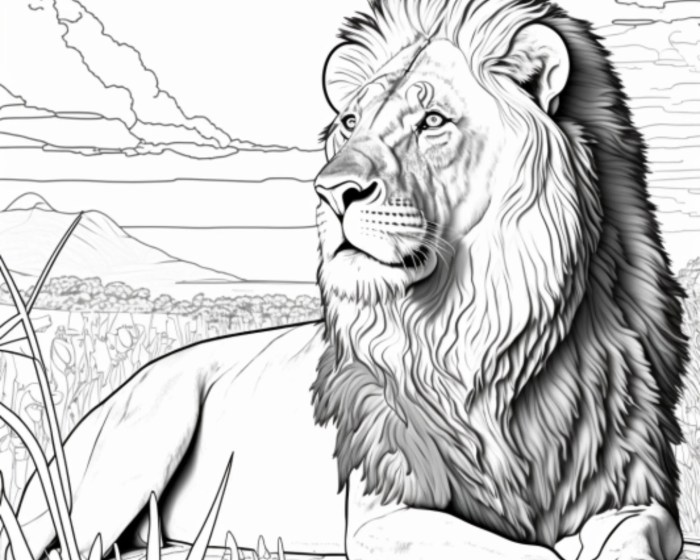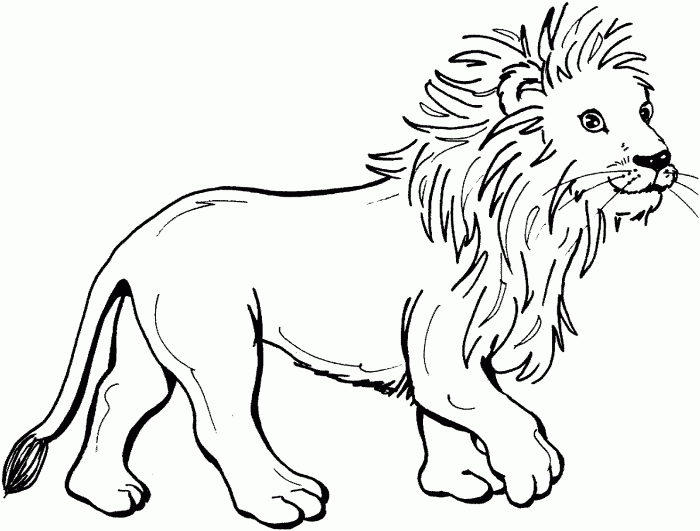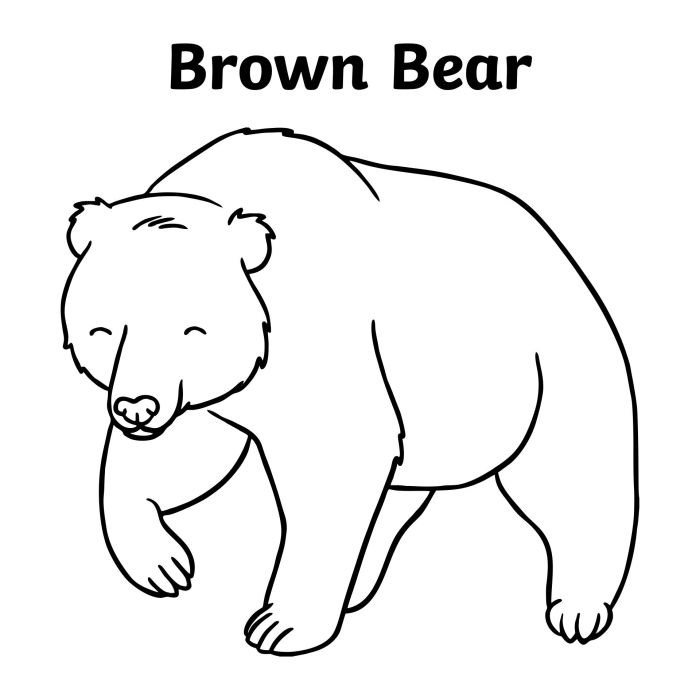Target Audience Identification

The primary purpose of a lion coloring book page is to provide an engaging and enjoyable activity for children. Therefore, accurately identifying the target audience is crucial for designing effective and appealing content. This analysis will focus on the age range, characteristics, and a representative user persona.The primary age range for lion coloring book pages encompasses children aged 3 to 8 years old.
This broad range accommodates varying developmental stages and skill levels in coloring and fine motor skills. While younger children might enjoy simpler designs with large areas to color, older children within this range may appreciate more intricate details and potentially even the incorporation of simple patterns.
Target Audience Characteristics
Children within the 3-8 age range exhibit a range of interests and skill levels relevant to coloring book pages. Their interests frequently include animals, especially majestic creatures like lions, and vibrant colors. Their skill levels in coloring vary considerably, from basic scribbling and large-area filling to more controlled line-following and shading techniques. Furthermore, many children at this age enjoy creative expression and the opportunity to personalize their coloring pages, adding their own unique touches and interpretations.
Ideal Customer Persona: Lily (Age 6)
To further clarify the target audience, consider Lily, a six-year-old girl. Lily enjoys animals, particularly lions, and has a growing interest in art and creativity. She is capable of coloring within lines most of the time, but still enjoys the freedom of expression that coloring provides. She might add her own drawings to the page, perhaps depicting a scene with the lion in a savanna setting.
Lion coloring book pages offer a classic, majestic theme for creative expression. For those seeking a different adventure, you might also enjoy the exciting characters found in star wars coloring book pages , which offer a galaxy far, far away to color. Returning to the king of the jungle, however, the detailed mane and powerful stance of a lion provide a satisfying challenge for any coloring enthusiast.
Lily prefers bright, bold colors and appreciates detailed designs, although she still needs designs that aren’t overwhelmingly complex. She might also enjoy simple accompanying activities, such as matching colors or drawing related objects. This persona exemplifies the typical user within the identified target audience, allowing for a more focused design approach.
Illustrative Details and Descriptions: Lion Coloring Book Page

This section provides detailed descriptions of a majestic lion, its paw, and a playful cub, offering suggestions for coloring techniques to bring these magnificent creatures to life on your coloring page. These descriptions aim to inspire creativity and enhance the coloring experience.The following subsections delve into the specific details of each element, offering guidance on texture, shading, and color choices.
Lion’s Mane
A lion’s mane is a symbol of its power and majesty. The texture can vary greatly, from a thick, coarse mass of hair to a more refined, flowing mane. When coloring, consider incorporating variations in shading to capture this depth. The base color might be a rich tawny or golden brown, but don’t hesitate to add darker shades in the inner parts of the mane to create shadows and depth.
Lighter highlights can be added to the outer edges to suggest the sun catching the individual strands. Experiment with different shading techniques, such as stippling or blending, to create a realistic and impressive mane. The mane’s thickness and length can also vary; some lions have full, impressive manes, while others have sparser, less prominent ones. This variability offers a chance for artistic expression.
Lion’s Paw
The lion’s paw is a powerful and intricate structure. The pads are tough and leathery, providing excellent grip and cushioning. When coloring, use darker shades of brown or grey to depict the pads, contrasting them with the lighter fur on the rest of the paw. The claws, sharp and retractable, should be depicted with a dark, almost black color, to highlight their sharpness.
Remember to incorporate subtle shading to emphasize the three-dimensional form of the paw; the pads should appear slightly raised, while the claws should recede into the shadows. Pay close attention to the way the fur flows around the claws and pads, showing texture and movement.
Lion Cub
A lion cub is characterized by its playful nature and soft features. Its fur is typically a lighter shade of brown or tan than an adult lion’s, often with a subtle mottled pattern. The cub’s face is rounder and more innocent than an adult’s, with large, expressive eyes. When coloring a lion cub, consider using softer, warmer tones.
Highlight the eyes with a brighter color to make them stand out, and use gentle shading to emphasize the roundness of the face and body. Don’t be afraid to add some playful touches, such as a slightly open mouth or a playful pose. The fur of a cub appears softer and fluffier than that of an adult lion, so using lighter strokes and lighter shading will convey this.
Consider adding a little bit of darker shading around the joints to indicate depth and form.
Enhancing the Coloring Experience

Elevating a lion coloring page beyond a simple line drawing involves thoughtful consideration of several design elements. Adding depth, visual interest, and engaging features can significantly improve the overall coloring experience for children. This section will explore various techniques to achieve this.
By incorporating additional elements, using varied line weights and textures, and designing an appropriate border, we can create a more captivating and enjoyable coloring experience. These enhancements cater to both the creative process and the final aesthetic appeal of the finished artwork.
Background Scenery and Textual Elements
Adding a background scene can greatly enhance the coloring page. Consider a savanna landscape with tall grasses, acacia trees, or perhaps a rocky outcrop. The background should complement the lion, not compete with it. The level of detail should be appropriate for the target age group; younger children might appreciate simpler shapes, while older children could handle more intricate details.
For example, a simple sun could be added behind the lion, or a pride of lions in the distance, subtly suggesting a family or social context. Adding small text elements, such as a short, age-appropriate poem or a fun fact about lions (“Lions are the kings of the jungle!”), could add an educational element. The font should be clear, simple, and large enough for easy coloring.
Line Weight and Texture Variations, Lion coloring book page
Utilizing varying line weights and textures adds depth and visual interest to the lion’s features. Thicker lines can be used to define the lion’s mane, emphasizing its thickness and texture. Thinner lines can be used for details like whiskers or individual strands of hair, creating a sense of realism and detail. Textured lines, achieved through stippling (small dots) or hatching (parallel lines), can be used to add shading and create a sense of volume, particularly within the mane and muscles.
For instance, closely spaced hatching could depict the shadow under the lion’s chin, while stippling could be used to suggest the texture of the lion’s fur.
Border Design
A simple border can frame the lion and enhance the overall presentation. A border featuring stylized grass, paw prints, or even a simple geometric pattern related to African motifs (like repeating triangles or diamond shapes) would complement the theme. The border’s color should be chosen to either complement or contrast with the lion’s coloring, creating a visually pleasing balance. A thin, elegant border will create a subtle frame, while a bolder border will add a more pronounced visual impact.
The purpose of the border is to define the coloring area, improve the overall aesthetic, and potentially add a decorative element that enhances the overall design. A simple, well-chosen border can elevate the entire coloring page from a simple drawing to a more finished piece of art.



